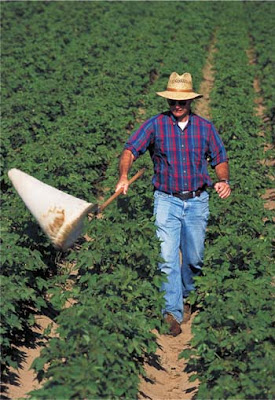The
uber-hot weather greeting the start of summer in the Valley is triggering a big
uptick in lygus bugs populating cotton fields.
Field
scout Damien Jelen is snaring four to five lygus for every 50 passes of his is
sweep net. In one field, he recorded eight pests per 50 sweeps. In comparison,
the count was one to two lygus bugs the previous week, which is about normal
for this time of year.
“The lygus
numbers are up. Growers are monitoring it. They do not want it to go on too
long,” Damien says.“The hot weather is contributing to the increase.”The
triple-digit temperatures along with harvesting of nearby alfalfa fields have
combined to boost the lygus numbers in cotton.
 |
| Sweep nets snaring lygus bugs in cotton. |
Here is
the lygus threshold from UC Integrated Pest Management:
· June 15-June 30: more than two lygus bugs per 50 sweeps
· Mid-Squaring (1st flower - 1st mature boll,
beginning of July): seven-10 lygus bugs
(at least one nymph) per 50 sweeps and expected or better fruit retention. If
retention is higher than expected you may be able to wait and monitor again
that week before making a treatment decision. If retention is lower than
expected and lygus bugs are present, consider treating.
·
Late Squaring (after 1st mature boll): 10 lygus bugs/50 sweeps,
including the presence of nymphs
“The above thresholds are guidelines to be used with square
monitoring, depending on the particular weather patterns. For example, during
warm springs they are very reasonable, because cotton is setting fruit early
and has high retention potential.Moreover, UC IPM adds: “In contrast, late plantings, vigorous cotton, and high plant populations promote lower fruit retention and therefore thresholds will be lower. Additionally, duration of fruit retention may vary according to the cotton cultivar present in the field. The longer the fruit is retained, the longer it will be attractive to lygus bug populations. Finally, success in retaining early squares will greatly determine the final yield; therefore protecting cotton during the early square formation period (June) is critical. Protection during the early season is very complex. Factors such as low lygus bug numbers, high susceptibility of cotton, and variability in sampling require the grower to be extremely vigilant and ready to act at an instant.”
 |
| Lygus numbers have increased in cotton fields. |
“If there is a spike by the end of the week, growers may order spraying,” Damien says. Growers should look at using reduced-risk materials.
There are two options for spray timing - during early fruiting when monitoring indicates lygus densities are low and square retention is only slightly off (5 percent), re-inspect the field again in three days if square retention continues to be slightly off normal. Use product that preserves natural enemies. When population densities of lygus are high and potential for repeated and sustained invasion, may needed quicker acting.
Here are some chemical options: There is some resistance to organophosphate, carbamate and pyrethroid insecticides. Suggested chemicals to use are Carbine, Belay,Steward, Diamond, Brigade, Baythroid or Warrior.
Damien reminds growers with alfalfa fields adjacent to their cotton to leave uncut strips of alfalfa during harvest. This will provide a habitat for lygus – which prefer to live in alfalfa than cotton – when the alfalfa is cut.
 |
| Almond growers are concerned about mites in their orchards. |
UC IPM notes that “mites damage foliage by sucking cell contents from leaves. The damage begins with leaf stippling. Leaves can turn yellow and drop off. High numbers of mites cover tree terminals with webbing. Crop reduction and reduced vegetative tree growth shows up the year after damage occurs.”
Jenna says almond hulls are starting to split in most orchards. “If growers have not done their hull split spray yet, it’s on their agenda.”







